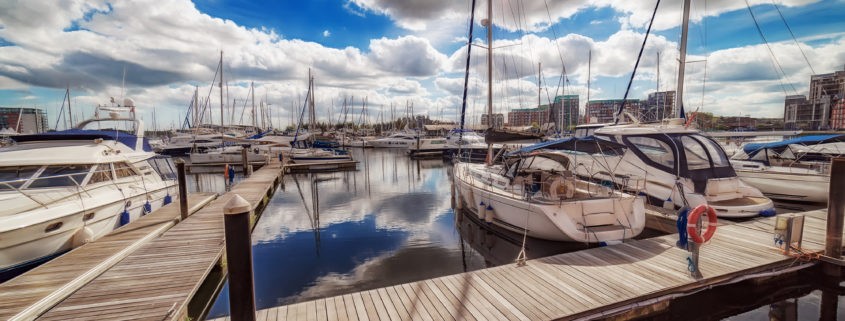What is AC stray current?
In a nutshell, all of the AC electrical current that comes from the dockside electrical system, through the shore power cable and onto your boat should return via the same path. The net result of this current flow should be zero.
For example, say you have a single 30 amp shore power cable supplying your boat. If you have an air conditioner running and a water heater heating, you’re probably pulling about 20 amps. All of the amperage your appliances are consuming is supplied through the 120v AC black “hot” wire of your shore power cable. All of that current should return to shore via the 120v AC neutral “white” wire in the same cable.
For safety reasons (in order to protect against possible shock or electrocution dangers), the 120v AC green “grounding” wire is connected on board your vessel to the DC ground system, which is in turn usually connected to a bonding system of the engine block. These are ABYC standards that define how your boat is wired. Long story short, if there is an electrical fault or problem of some sort, electricity has a path to ground through your boat and into the water. This means it is not returning to shore via your shore power cable.

How do we check for stray AC current?
We use a special AC amp meter and clamp it over your shore power cable. No matter which AC appliances are running on the boat, this reading should be at or near zero amps. This means that the net result of all current flow entering the boat minus all the current flow leaving the boat through the shore power cable is zero.
Some small amounts of AC stray current is acceptable. The accepted threshold is 30 milliamps (mA). This mirrors the trip point of residential GFCI 120v AC outlets you likely have in your house in kitchens and bathrooms. Anything under and up to 30 mA is not considered lethal to humans.
What are the risks of excessive AC stray current?
For people on your boat – hopefully the wiring and supporting systems are in good shape and this stray current is travelling through it, going harmlessly into the water. However, scenarios could easily arise where people on board could be at risk of experiencing electric shocks when touching certain metal objects (faucets, thru-hulls, etc.).
For people in the water around your boat – While the probability of this may seem remote, numerous drownings have been attributed directly to AC stray current in the water originating from electrical faults on adjacent boats. If levels in the water are high enough, muscles can uncontrollably contract, resulting in drowning. Divers regularly can detect a “tingling” sensation when levels are high enough. This is one of the reasons no swimming should be allowed in marinas. Children especially are susceptible to this. Keep in mind also that boating is a leisure activity, often with alcohol involved. An accidental trip or slip resulting in a fall into the water could be catastrophic.
What is the recommended course of action if excessive stray current is detected?
If our First Mate Checkout technician detects stray current above the 30 mA threshold, we first confirm our reading with a second meter. Once the reading is confirmed, we need to make the determination as to whether the electrical fault is originating on the boat or from the dock (it could be from another vessel in the area or a problem with the dock’s wiring). The next step is we turn off all main AC breakers on the vessel. If the stray current goes away (returns to levels under 30 mA), we know with certainty there is an electrical fault on the boat. However, just because it doesn’t go away doesn’t mean we can assume the boat is not the source. At this point, it requires a more in-depth inspection and analysis by one of our ABYC certified Marine Electricians, and the use of special break-out shore power cable adapters to isolate the problem. If the determination is made the problem is on the boat, we can continue troubleshooting and make recommendations for repairs once issues are identified. Depending on the complexity of the vessel’s AC electrical system, this could be brief or very time consuming. If we find the problem originates from the dock, we inform the marina of the situation and they have their electrical contractor investigate further (we regularly work with marinas to solve these types of problems). In any case, this situation should be taken seriously. Bad things can happen very quickly.
Important Point:
The presence of AC stray current can be affected by numerous factors. What appliances on board the boat that happen to be running or cycling at the moment AC stray current is checked is a major one, for instance. Also, what AC equipment other boats in the area may have in operation can also significantly impact the situation. Weather conditions, tide levels, ambient temperatures, etc. can all play a part in the overall equation and make electrical faults more or less present and detectable. The important thing to remember is clamping the shore power cable(s) with a meter takes an accurate reading at that point in time (a snap-shot, so to speak). We cannot guarantee there is no AC stray current present under different conditions at other times. However, by checking for AC stray current as part of our First Mate Checkout Program every two weeks, we provide you the best chance to identify, catch, and correct potentially dangerous issues that could be present.
Where to find us
True North Marine
Full Service Shipyard& Dockside Support
1206 Marina Bay DriveClear Lake Shores, TX 77565
281.549.4300
info@truenorth-marine.com
